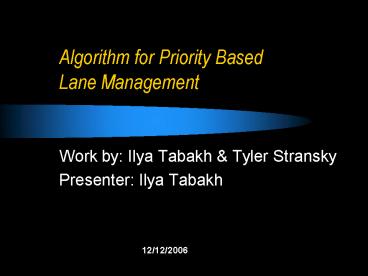Algorithm for Priority Based Lane Management PowerPoint PPT Presentation
1 / 24
Title: Algorithm for Priority Based Lane Management
1
Algorithm for Priority Based Lane Management
- Work by Ilya Tabakh Tyler Stransky
- Presenter Ilya Tabakh
12/12/2006
2
Outline
- Introduction
- Background
- Preliminary Quantification
- Protocol Design
- Future Work
3
Outline
- Introduction
- Background
- Preliminary Quantification
- Protocol Design
- Future Work
4
Introduction
- Project Deals with an algorithm to handle issues
in using managed lanes - Goal is efficient utilization of existing
resources - HOV are among the most prevalent managed lanes.
Natural place to start.
5
Outline
- Introduction
- Background
- Preliminary Quantification
- Protocol Design
- Future Work
6
Background
- Congestion is Increasing
Weekday Peak-Period Congestion Has Grown in
Several Ways in the Past 20 Years in Our Largest
Cities
Congestion Has Grown Substantially in U.S. Cities
Over the Past 20 Years
1
7
Background
- Managed Lanes
2
8
Background
- Managed Lanes
2
9
Background
- Available simulation environments
- NS-2 3
- No concept of physical traffic network
- Discrete event simulator
- Not a production simulator
- CORSIM 4
- Can simulate a network consisting of street as
well as freeway traffic - Reports on MOEs (Measures of Effectiveness, ie
Average Network Speed)
10
Outline
- Introduction
- Background
- Preliminary Quantification
- Protocol Design
- Future Work
11
Preliminary Quantification
Various properties of the network are specified
here vehicle flow carpools cheaters
12
Preliminary Quantification
- Queuing in Simulation (Gridlock)
Q Queuing NQ No Queuing
13
Preliminary Quantification
- Freeway
- Average speed and ratio of move/total is
proportional to car pool - Bus performance is decreased slightly (no
preemption) - Street
- Results are similar
- In street scenario bus dwells in active lane
14
Outline
- Introduction
- Background
- Preliminary Quantification
- Protocol Design
- Future Work
15
Protocol Design
- Assumption
- All vehicles are equipped with GPS
- Provides the following
- Direction
- Speed
- Location
- Vehicles have sufficient performance to do
signatures and communication in sub human
reaction time scale
16
Protocol Design
- Consideration for Bus (High Priority)
- Transmits a bus coming message
- Need to be able to sign message
- Provide location and heading
17
Protocol Design
- Bus Protocol Component
Contains Location, Velocity and signature
Send Message
Receive ACK(s)
Warn Driver when necessary
If vehicle will not leave lane take picture
Contains Location and Velocity
18
Protocol Design
- Consideration for Car (Low Priority)
- Need to know if in Managed Lane
- Need to be able to authenticate bus
19
Protocol Design
- Car Protocol Component
Receive and Authenticate Message
Send ACK(s) until lane is vacated
Identify lane
1
3
5
Listen for messages
If Bus within range warn driver
2
4
20
Protocol Design
- Qualitative Overhead analysis
- Going the speed limit (65 MPH) a car is moving
about 96 ft/sec - Human driving reaction time is on the order of 1
second - The assumption that was made is not unreasonable
21
Outline
- Introduction
- Background
- Preliminary Quantification
- Protocol Design
- Future Work
22
Future Work
- Simulate network along with physical traffic
- Perform simulation with priority preemption of
vehicles - Account for number of passengers in HOV vehicles
23
Questions!?!?
24
References
- 1 FHWA Traffic Congestion and Reliability
Trends and Advanced Strategies for - Congestion Mitigation
- 2 Managed Lanes Handbook
- http//tti.tamu.edu/documents/0-4160-24.pdf
- 3 The Network Simulator - ns-2
- http//www.isi.edu/nsnam/ns/
- 4 McTrans TSIS
- http//mctrans.ce.ufl.edu/featured/TSIS/

